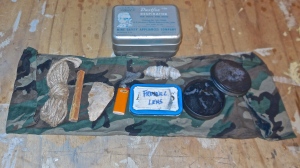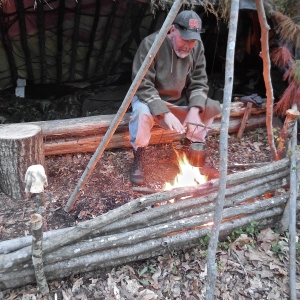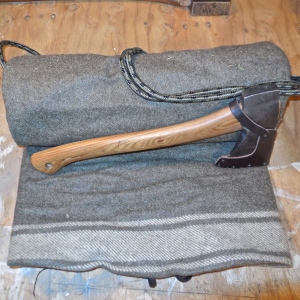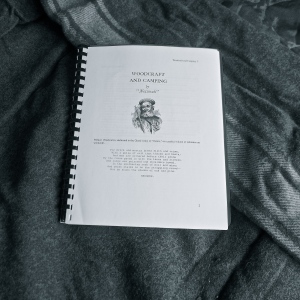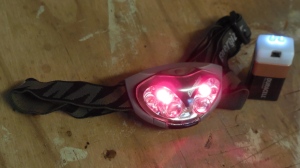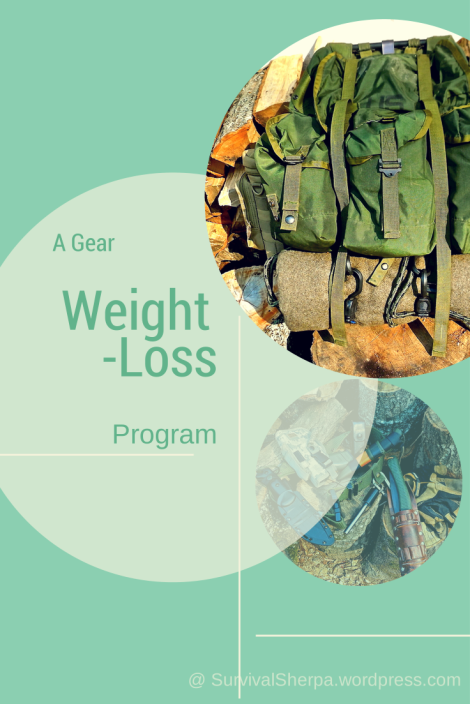 Doing the Stuff with your gear is the most overlooked skill in the world of prepping and survivalism. In general, we tend to think un-tested gear will get us through any crisis. Just whoop out that new shiny object from your kit… you know, you’ve seen the YouTube videos.
Doing the Stuff with your gear is the most overlooked skill in the world of prepping and survivalism. In general, we tend to think un-tested gear will get us through any crisis. Just whoop out that new shiny object from your kit… you know, you’ve seen the YouTube videos.
Imagine this…
You and your family are forced, for whatever reason – really doesn’t matter why, to grab your bug out bags and get out of dodge… on foot. You’ve got 5 minutes to get out. Immediately you realize the weight of your bag alone will make your journey impossible.
Time to go on a weight-loss program – for your gear!
As some of our regular readers know, I’ve built a semi-permanent shelter in the woods. It’s my personal space where I go to get centered, re-humanized, and enjoy nature. From a survival point of view, my personal space gives me a convenient location to build skills.
More importantly, it’s a weight-loss center for gear. It does a pretty good job of keeping extra pounds off the body too.
On to the gear weight-loss program.
My first overnight outing in my shelter helped me lose extra gear weight. Granted, it was only a one-night-stand. But that one night with a new ALICE pack (All-Purpose Lightweight Individual Carrying Equipment) was needed to compare with my old 3-day assault bag.
You see, with larger packs, I tend to over pack. The smaller ALICE forced me to downsize and prioritize my gear. Anytime I head out for some dirt time I pack, at a minimum, the first five of Dave Canterbury’s 10 C’s of Survival. This trip was no different with one exception…. I overpacked ALICE to test her fit, finish, carrying capacity, and comfort.
Below you’ll see what I packed, what I actually needed, and what I’llleave behind next time. I packed way too much stuff for an overnight trip. But remember, I needed to get ALICE in the woods for the first time.
Stuff I Packed
Dave’s 5 C’s
1.) Cutting tools. These items are the hardest to trim for me. My only excuse is that I love sharp stuff!
- BK2 – A pure tank of a knife with a 1/4″ full tang 1095 steel blade.
- Mora Companion – I find it more useful around camp for finer knife work. It rides around my neck via a lanyard.
- Opinel #8 folder
- Leatherman multi-tool
- Swiss Army Knife – Stays in my right pant pocket whenever I leave the house.
- Bacho Laplander – This folding saw was used for a lot of cuts on my shelter.
- Ax – Wetterlings 16″ Hunter’s Ax. Small enough to fit into my rolled up bedroll, yet large enough to handle most tasks around base camp.
- Almost Free Ax – I know, overkill for one night. Told you sharp stuff was my kryptonite.
2.) Combustion. Fire is life out there.
Fire kit fits inside the tin at the top
- Lighter
- Ferro rod
- Flint and steel
- Char tin and charred material
- Fat lighter’d (fat wood)
- Water proof jute twine and other dry tinder material
- Mini Inferno (water proof fire starter)
3.) Cover. My trapper’s shelter was my cover for the night. However, redundancy give you options…
Morning coffee!!
- USGI poncho
- Contractor trash bag x2
4.) Container. For cooking, water, etc.
- Stainless Steel Bottle Cook Set
- A #3 tall can as a modification on the above mentioned cook set
5.) Cordage. Hard to make in the wilderness – easy to just pack some in your kit.
- 50 ft. of paracord
- 25 ft. of #36 tarred bank line
- 50 ft. of climbing rope
- Two short bungee cords for my bedroll
The rest of Dave’s 10 C’s of Survival
6.) Candle (lighting)
- Headlamp for hands free illumination
- Pak-lite LED Flashlight – Great for lighting your shelter is the weight of a 9v battery
- StreamLight ProTac 2L – 3 modes: bright, dim, and strobe and will light up the woods – doubles a my EDC pocket light
- LightSpecs – almost forgot these LED reading glasses that ride on my head
7.) Cotton. 100% cotton rag or bandana can be used for bandaging wounds, char cloth, and many other survival uses.
- Large bandana
- Small squares of bath towel (future char cloth)
8.) Compass for navigation
9.) Cargo tape. This may be the most versatile item in your kit.
- Gorilla tape
- Electrical tape from my Cigar Fishing Kit – orange in color for marking trail or signaling rescuers to your path
10.) Canvas needle. From repairing gear in the field to removing splinters.
- Sail needle
- Dental floss
That’s the 10 C’s. Now for the other stuff.
Bedroll
Wool blanket with ax tucked into the roll
- 100% queen-size wool army blanket
- USGI poncho liner
- Section of the billboard for a ground cloth (already at the shelter)
Food
- Poached my bug out bag food bag – overkill again
- Coffee and tea
Water
- MSR Miniworks Micro filter
Sidearm
- Springfield XD 9mm
- 2 magazines
- No long gun this trip
Clothing
- Extra long sleeve shirt and the clothes on my back
- Homemade wool hunting shirt
- Boonie hat
Book
Woodcraft and Camping
- Woodcraft and Camping by “Nessmuk”
- Journal and pencil
Stuff I Needed
The first 5 C’s
1.) Cutting tools
By far the most used knife was my Mora Companion neck knife. There wasn’t a lot of heavy-duty campcrafting needed so my BK2 stayed in its sheath. I did cut a sapling with the BK2 to mount a frog gig on the end. Also used the packaging tool on my SAK to tighten bank line lashing on the cooking tripod I made.
The Wetterlings ax saw minor action harvesting saplings for the cooking tripod. The Almost Free Ax was never unmasked.
The pliers on my multi-tool was used to remove a container of boiling water from the toggle on the tripod.
The Bacho folding saw was use to harvest dead-fall poplar wood for a bow drill set. To shape my spindle, the Mora was all I needed.
Cutting Tools I’d Leave Behind
- Opinel folding knife
- Almost Free Ax
2.) Combustion
Used a Bic lighter and feathered fat lighter’d stick to light the camp fire. I was lazy and didn’t feel like practicing primitive fire skills. That’s why I carry a lighter.
Combustion Items I’d Leave Behind
NONE! Fire is life.
3.) Cover (Shelter)
My shelter was already built. I still carried my poncho which came in handy as an extra layer of insulation over my wool blanket.
Cover Items I’d Leave Behind
NONE!
4.) Container
The cook set served me well alone. With more than one person, a larger cooking pot/pan would be needed.
Container Items I’d Leave Behind
NONE! Add a larger bush pot.
5.) Cordage
The 25 ft of tarred bank line was used to lash the cooking tripod. Since my shelter was already built, no other cordage was needed.
Cordage Items I’d Leave Behind
NONE! Pack 50 ft of tarred bank line next trip.
6.) Candle (lighting)
My LightSpecs, headlamp, and Pak-lite saw the most action on this trip. A couple of times I almost reached for my StreamLight as the coyotes got closer in the middle of the night.
Red light saves night vision
Candle Items I’d Leave Behind
Pak-lite LED flashlight. Although, for the small amount of added weight, I’d probably keep it in my kit.
#7-10 – Cotton, compass, cargo tape, and canvas needle (repair kit) would stay the same.
Other Stuff
It’s really not surprising, at least to me, that I didn’t drop much weight on the 10 C’s. Those items are essential to survivability. With these tools and the knowledge and skill to use them, you increased your odds of comfortably surviving a wilderness or bug out journey.
Lessons Learned
A.) The importance of thermoregulation can’t be overstated – even in 45º temperatures. By 2 AM, I woke up to cold feet. I had let the fire die down and had not collected enough fuel to see me through the entire night. I draped my poncho over the wool blanket to add an extra layer of insulation. This did the trick.
Another point worth discussing is the lack of insulation between me and the ground. Though the ground wasn’t frozen like our neighbors to the north, the ground cloth and poncho liner was too minimalist. My remedy will be to add a foot of dried leaves and straw with the billboard on top of that layer as a moisture barrier.
B.) On firewood: Collect two or three times the amount you think you’ll need for the night. The shelter was designed to capture radiant heat via the reflecting wall and the overhang on the front of the shelter. The cool weather wouldn’t have been a problem if I had harvested enough fuel.
C.) For practice runs of one or two nights out, lose as much gear weight as you comfortably can. Make a note (an actual list) of what you needed and what turned out to be extra weight. Pack accordingly on your next outing.
For instance, I primarily used one knife. That knife should be a full tang, 5 inch high carbon steel blade or longer, 90º angled spine, and non-coated. For me it’s my BK2. Although I use my Mora as a backup.
D.) My water filter wasn’t working properly. I boiled water for cooking and drinking via the bottle cook set.
To loose gear weight, you have to test your stuff. Your bug out bag or bushcraft kit should be in constant state of evolution not a shiny object storage compartment. There’s no such thing as a perfect kit. But that doesn’t stop us from trying to create one.
As skills increase, gear will decrease.
What skill would help you lose gear weight?
Keep Doing the Stuff,
Todd
P.S. – You can also keep up with the Stuff we’re Doing on Twitter, Pinterest, Google +, and our Facebook page. Ready to trade theory for action? Join us in the Doing the Stuff Network on these social media sites: Pinterest, Google +, and Facebook. Use the hashtag #DoingTheStuff when sharing your stuff on Twitter.
This article was originally published at Ready Nutrition™ on April 17th, 2014


